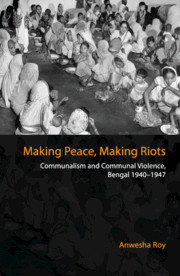Book contents
- Frontmatter
- Frontmatter
- Contents
- Maps and Figures
- Acknowledgements
- Abbreviations
- Glossary
- Introduction
- 1 The Dacca Riot, 1941
- 2 Famine 1943 – Towards a Hardening of Community Identities
- 3 From Community to Communal: The Bengal Secondary Education Bill and the Idea of Pakistan
- 4 The Great Calcutta Killing, August 1946
- 5 Noakhali Riots, October 1946
- 6 A Test of Faith: Gandhi in Noakhali and Calcutta 1946–47
- Concluding Remarks
- Appendix 1
- Appendix 2
- Appendix 3
- Appendix 4
- Bibliography
- Index
Appendix 4
Published online by Cambridge University Press: 23 October 2018
- Frontmatter
- Frontmatter
- Contents
- Maps and Figures
- Acknowledgements
- Abbreviations
- Glossary
- Introduction
- 1 The Dacca Riot, 1941
- 2 Famine 1943 – Towards a Hardening of Community Identities
- 3 From Community to Communal: The Bengal Secondary Education Bill and the Idea of Pakistan
- 4 The Great Calcutta Killing, August 1946
- 5 Noakhali Riots, October 1946
- 6 A Test of Faith: Gandhi in Noakhali and Calcutta 1946–47
- Concluding Remarks
- Appendix 1
- Appendix 2
- Appendix 3
- Appendix 4
- Bibliography
- Index
Summary
Source: S. P. Mookerjee Papers, NMML, VIII- IX Instalment, Subject File No. 4, 1943-44, page 79
Full text of the letter sent by Srijib Nayatirtha, Principal of Bhatpara Sanskrit College, 24 Parganas, to the Minister of Civil Supplies, Government of Bengal, 1944
Sir,
In pursuance of the debate held on 14th instant in your assembly room regarding the question of bhog puja of deities within the rationed area of Bengal, I have the honour to state that the idea of worshipping deities with offerings of flowers, fruits and rice etc. among the Hindus is prevalent from very ancient times. This kind of worship is a part and parcel of Hindu civilization, and worth maintaining in consideration of its antiquated practice.
The want of provision of bhog puja of deities in the rationing area of Bengal has created a vital problem and wounded the religious feeling of the Hindu public. The sooner the provision is made, the less would be the trouble of both the Hon'ble ministers and the Hindu public of Bengal.
If we analyse the whole demands for bhog puja, they will come under four broad classifications:
i. Daily worship of household deities
ii. Deities and rites within endowments
iii. Occasional Pujas and Vratas
iv. Sradha ceremonies
Regarding (i) Class or household deities, there are two classes: (1) with temple and (2) without temple. Wherever there is a temple, the offering of rice is invariably given to the priest, the owner is not permitted to use the offered rice, and as the priest has generally no other means of living, so he has to depend upon that offering to maintain himself and his family. The priest has to perform pujas in many temples every day. Consequently, if his ration card is taken for offering rice in one temple, the question of providing other temples remains unsolved.
There are deities installed in one of the rooms of the house, who are worshipped every day and offered rice. In the houses of Brahmans the deities are allowed to be worshipped by the house-holder himself, and in such cases only the offered rice may be utilised. But few Brahmans do so. But in cases of non-Brahmans (except a few deities) all are worshipped by other Brahmans of priest class, to whom the offering of rice (Naivedya) must be given without exception.
- Type
- Chapter
- Information
- Making Peace, Making RiotsCommunalism and Communal Violence, Bengal 1940–1947, pp. 260 - 262Publisher: Cambridge University PressPrint publication year: 2018



